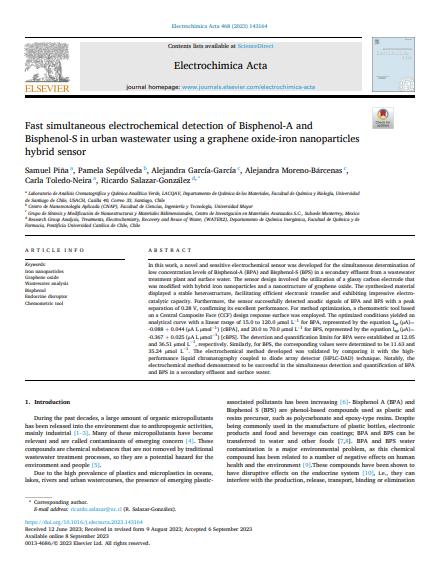Fast simultaneous electrochemical detection of Bisphenol-A and Bisphenol-S in urban wastewater using a graphene oxide-iron nanoparticles hybrid sensor

Fecha
2023-11-10Autor
Piña, Samuel
Sepúlveda, Pamela [Univ Mayor, Fac Ciencias, Ctr Nanotecnol Aplicada CNAP, Chile]
García-García, Alejandra
Moreno-Bárcenas, Alejandra
Toledo-Neira, Carla
Salazar-González, Ricardo
Ubicación geográfica
Notas
HERRAMIENTAS
Acceda a títulos restringidos
¿Cómo descargar?Resumen
In this work, a novel and sensitive electrochemical sensor was developed for the simultaneous determination of low concentration levels of Bisphenol-A (BPA) and Bisphenol-S (BPS) in a secondary effluent from a wastewater treatment plant and surface water. The sensor design involved the utilization of a glassy carbon electrode that was modified with hybrid iron nanoparticles and a nanostructure of graphene oxide. The synthesized material displayed a stable heterostructure, facilitating efficient electronic transfer and exhibiting impressive electro-catalytic capacity. Furthermore, the sensor successfully detected anodic signals of BPA and BPS with a peak separation of 0.28 V, confirming its excellent performance. For method optimization, a chemometric tool based on a Central Composite Face (CCF) design response surface was employed. The optimized conditions yielded an analytical curve with a linear range of 15.0 to 120.0 mu mol L-1 for BPA, represented by the equation Iap (mu A)=-0.088 + 0.044 (mu A L mu mol-1) [cBPA], and 20.0 to 70.0 mu mol L-1 for BPS, represented by the equation Iap (mu A)=-0.367 + 0.025 (mu A L mu mol-1) [cBPS]. The detection and quantification limits for BPA were established at 12.05 and 36.51 mu mol L-1, respectively. Similarly, for BPS, the corresponding values were determined to be 11.63 and 35.24 mu mol L-1. The electrochemical method developed was validated by comparing it with the high-performance liquid chromatography coupled to diode array detector (HPLC-DAD) technique. Notably, the electrochemical method demonstrated to be successful in the simultaneous detection and quantification of BPA and BPS in a secondary effluent and surface water.
URI
https://repositorio.umayor.cl/xmlui/handle/sibum/9501https://doi-org.bibliotecadigital.umayor.cl:2443/10.1016/j.electacta.2023.143164
https://doi.org/10.1016/j.electacta.2023.143164
Coleccion/es a la/s que pertenece:
Si usted es autor(a) de este documento y NO desea que su publicación tenga acceso público en este repositorio, por favor complete el formulario aquí.